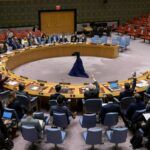Supporting science at the nuclear weapons labs
By Frances Fragos Townsend, Lt. Gen. Donald Kerrick | March 10, 2009
During the 1970s and 1980s, the size of the U.S. nuclear weapons budget allowed for a healthy amount of high-risk, long-term basic research to be conducted at the nation’s nuclear weapons laboratories. Much of this research grew out of, but diverged from, the labs’ core weapons-related capabilities. Importantly, the wide-ranging capabilities at these laboratories allowed other national security agencies to tap into that expertise on an “as needed” basis without making the long-term investments necessary to build and sustain it.
Since the end of Cold War, the United States has not achieved a corollary–a resilient science and technology base responsive to diffuse and much-less tangible threats. Although the nuclear weapons labs have long operated as broad national security institutions, their capabilities are not being leveraged to the maximum extent possible. This is due to myriad factors, not the least of which is the lack of an integrated, government-wide strategy and governance structures that would allow for multi-agency prioritization of science and technology requirements and corresponding long-term investments.
To address this mismatch, the Stimson Center (with support from the National Nuclear Security Administration [NNSA], the Richard Lounsbery Foundation, and the Ford Foundation) convened a bipartisan task force to provide the new administration with a roadmap to more effectively leverage the existing capabilities at the nation’s nuclear weapons laboratories and Nevada Test Site (NTS) to meet an array of emerging vital national security challenges. On March 5, the task force released its final report “Leveraging Science for Security: A Strategy for our Nuclear Weapons Laboratories in the 21st Century,” which reflects the consensus view of the task force.
Through the course of site visits, interviews, and research, the task force identified several roadblocks to achieving this vision. Firstly, the tools available to NNSA and the weapons labs are limited. During the past year, NNSA pursued the concept of concluding “strategic” memorandums of understanding (MOUs) with other agencies that consistently use lab capabilities to achieve their own mission. The first of these MOUs was concluded in December last year with the Defense Threat Reduction Agency to jointly invest in munitions research over a five-year period. The major advantage of the MOU approach is that it alone offers the possibility of a long-term investment in capabilities of mutual interest. However, the task force questioned whether it is feasible to attain the number and variety of such agreements necessary to ensure retention of a broad range of capabilities at the labs. In addition, the funding commitment of MOUs is non-binding.
Similar challenges confronted the possibility of employing work-for-others strategies. Such arrangements are largely piecemeal, and current and former lab directors repeatedly suggested that you cannot sustain the labs through hundreds of short-turnaround, small-budget activities. In addition, it would be hard to imagine achieving the coordination necessary to allow the labs sufficient autonomy to compete for such opportunities, while ensuring their actions are in accordance with a government-wide national security, science and technology strategy.
The task force also investigated the potential role of industry partnerships with the labs. Yet it found that with the exception of some fairly lucrative partnerships with a handful of companies, industry comes to the labs for solutions to specific problems, not for purposes of sustained collaboration. In addition, the task force determined that industry partnerships cannot grow to a level requisite to offset even minor declines in nuclear weapons funding.
Beyond the limited tools at their disposal to support robust scientific capabilities, the labs face two institutional limitations. The task force’s fact-finding missions repeatedly found that the relationship between the Energy Department/NNSA and the labs is fractured, if not broken. While the parties once enjoyed a partnership, a sense of a shared mission has significantly eroded. Representatives of the labs repeatedly expressed the need for more federal leadership and less federal management. Absent the direction they desire, the labs often turn to Congress to try to override headquarters, giving rise to a vicious circle.
The loss of a clear, urgent mission within the labs has led to a culture of risk aversion. Combined with Energy’s severely risk-averse culture and the overarching fact that NNSA never achieved the autonomy intended by Congress, the labs’ more lucrative and synergistic opportunities confront painstaking processes that require approval across numerous stovepipes. Although the weapons labs made a big pitch for their relevance in achieving energy security, which is getting increasing attention from Washington, the task force neither saw enough overlay between the traditional mission and the labs’ energy work to sustain many of their needed capabilities, and the money that may flow to these labs is unlikely to compensate for the loss of defense program funding.
The future of the weapons labs will be largely influenced by several ongoing activities outside of Energy: the congressional commission on the U.S. strategic posture and a legislative mandate for a new posture review in 2009; insufficient congressional consensus on the role of U.S. nuclear forces; the lack of progress on obtaining key elements of the 2001 Nuclear Posture Review’s “responsive infrastructure”; and recent changes in congressional committee leadership. If Congress and Energy don’t prepare viable solutions to the science and technology infrastructure needs today, then this confluence of factors could lead to decisions with cascading, unintended consequences detrimental to U.S. security.
The task force identified one option that had the potential to address these challenges. Congress should create a fully autonomous Agency for National Security Applications (ANSA) that, much like NASA, would operate as an independent agency, reporting to the executive branch. The new agency would have a board of governors that would be equivalent to a board of directors and would be comprised of officials from all relevant national security agencies. Each board member would be asked to make a strategic investment in the science and technology infrastructure and be an active partner in setting its long-term national security requirements. This is not a government as usual solution. Although several non-cabinet-level working groups function in a similar fashion, there is no analogous government entity at this level.
A course of inaction is not option. The nation needs a vibrant science and technology infrastructure to address a burgeoning menu of national security challenges. The task force’s fact-finding revealed the unique and highly relevant scientific and technological wherewithal that the nuclear weapons laboratories can apply to today’s most pressing security challenges–nuclear forensics, nonproliferation, and counterterrorism. Implementing the solution we propose would require government-wide recognition of this capability and a willingness on behalf of government to provide strategic investments to ensure retention of these broad capabilities. Congress, the White House, and the agencies that rely on these assets must act now to ensure that the nation is not caught without the scientific expertise necessary to address its most significant security challenges in the coming years.
Together, we make the world safer.
The Bulletin elevates expert voices above the noise. But as an independent nonprofit organization, our operations depend on the support of readers like you. Help us continue to deliver quality journalism that holds leaders accountable. Your support of our work at any level is important. In return, we promise our coverage will be understandable, influential, vigilant, solution-oriented, and fair-minded. Together we can make a difference.
Topics: Opinion














